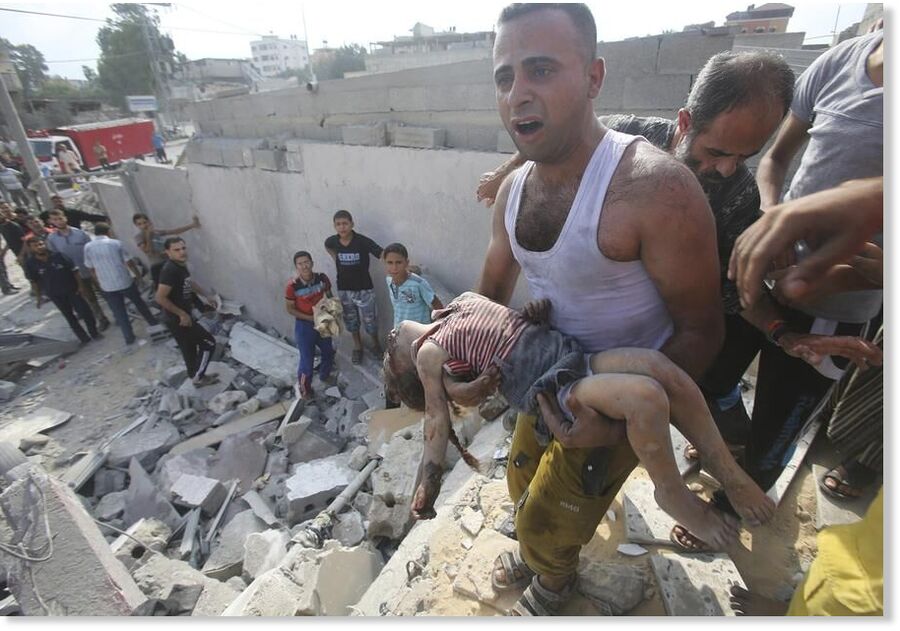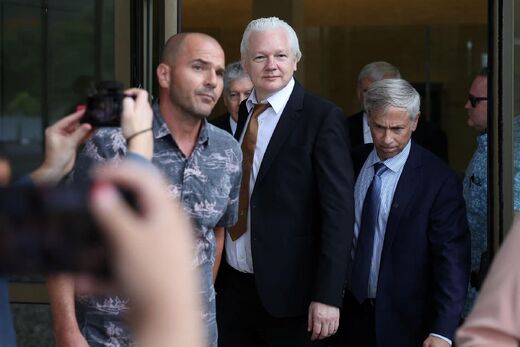Hamas triggered the war last October 7 with a surprise attack — there is so far no official explanation for Israel's security failure that day — that killed 1,139 Israelis and injured 3,400 more. Some 250 soldiers and civilians were taken hostage.
Comment: There is plenty of evidence to strongly suggest that Israel allowed the incursion on Oct. 7th to happen and that parties unknown carried out most of the killing. This strategy fits with Israel's decades-long goal of creating the right 'conditions' to justify implementing a final solution to their 'Palestinian problem'.
The expected Israeli response began within days, with the bombing of the Gaza Strip. Some Israeli ground operations inside Gaza began on October 13, and two weeks later the expected full-scale offensive began. The war still rages, with one estimate concluding that by the beginning of April 70,000 tons of explosives had been dropped on targets throughout the 25-mile long Gaza, more tonnage than was dropped by Germany on London and by America and the United Kingdom on Dresden and Hamburg in World War II, combined.
The Gaza Health Ministry, which is under Hamas control, estimated as of Tuesday that the death toll from the Israeli attacks stood at 37,718, with more than 86,000 Gazans wounded. Last month the Israeli government issued a much lower estimate of the casualties, stating that its planes and troops had killed 14,000 "terrorists" — Hamas fighters — and no more than 16,000 civilians.
The Biden administration, on the eve of the first presidential debate, has said nothing about the new numbers, but there are many senior analysts in the international human rights and social science community who consider these numbers to be hokum: a vast underestimate of the damage that has been done to a terrorized civilian population living in makeshift tents and shelters amid disease and malnutrition, with a lack of sanitation, medical care, and medicines as well as increasing desperation and fatigue.
In days of telephone and email exchanges with public health and statistical experts in America I found a general belief that the civilian death toll in Gaza, both from the bombings and their aftermath, had to be significantly higher than reported, but none of the scientists and statisticians — appropriately — was willing to say so in print because of a lack of access to accurate data. I also asked one well-informed American official what he thought the actual civilian death count in Gaza might be and he answered, without pause: "We just don't know."
One public health expert acknowledged: "No clear and definite body count is possible, given the continuing Israeli bombing." He added, caustically, "How many bombs does it take to kill a human being?"
Gaza was an ideal target for an air attack, he said. "No functioning fire department. No fire trucks. No water. No place to escape. No hospitals. No electricity. People living in tents and bodies stacked up all over . . . being eaten by stray dogs.
"What the fuck is wrong with the international medical community?" he asked. "Who are we kidding? Without a ceasefire, a million people are going to starve. This is not a debating point. How can you count something when the system is biting its own tail." He was referring to the fact that the health system in Gaza — its hospitals and service agencies — "is being targeted and shattered" by Israeli aircraft and those responsible for the counting of the dead and injured "are themselves dead."
The expert added that the lack of better casualty statistics is not only the fault of Israel. "Hamas has a vested interest in consistently minimizing the number of civilians killed "because of a lack of planning over the years when it was in charge of Gaza." He was referring to ordinary Gazan citizens' lack of access to Hamas's vast underground tunnel complex that could have served as a bomb shelter for all. In Gaza during the Israeli bombing raids, "Is Hamas going to say that Israel" was able to kill all in Gaza "because we started a war without being able to fully protect our people?" His point was that Hamas has every reason, as does Israel, to minimize the extent of innocent civilians who have become collateral damage in the ongoing war.
Comment: Hamas did not start this most recent round of mass slaughter by Israel on Oct 7th. Hamas has never provided Israel with the justification it always sought to massacre Gazans wholesale. On Oct. 7th, Israel provided itself with that justification.
A prominent American public health official who spoke to me acknowledged that he was also concerned about the numbers of unreported dead in Gaza. In a crisis, he said, "we can start with a name-by-name count, but pretty soon the numbers of killed and missing exceed the capacity of any such approach, especially when the counters are being killed and the records [are] at risk." He said that various postwar academic studies of mortality during the siege of Mosul — when a US-led coalition fought a door-to-door fight in 2017 against the Islamic State in Iraq, killing as many 11,000 civilians — "showed the large loss of life from the use of high-velocity weapons in urban areas. So we should expect similar in Gaza."
Other data suggest that the published death figures are seriously misleading. Save the Children, an international child protection agency, issued a report this month estimating that as many as 21,000 children in Gaza are "trapped beneath rubble, detained, buried in unmarked graves, or lost from their families." Other children, the agency said, "have been forcibly disappeared, including an unknown number detained and forcibly transferred out of Gaza" with their whereabouts unknown to the families "amidst reports of ill-treatment and torture."
Comment: As if the mass slaughter and starvation of Palestinians in Gaza is not enough, it is highly likely that a large number of Palestinian children have been abducted by Zionist state forces, likely to be tortured and killed or otherwise used for the depraved pleasures of some of the people that inhabit that "shitty little country".
Jeremy Stoner, the charity's regional director for the Middle East, said: "Gaza has become a graveyard for children, with thousands of others missing, their fates unknown. . . . We desperately need a ceasefire to find and support the missing children who have survived, and to prevent more families from being destroyed."
Warnings about the inevitability of far more deaths among the ordinary citizens of Gaza have been around since last winter. In December, Devi Sridhar, the chair of global public health at the University of Edinburgh, wrote in the Guardian that the Gaza war was "the deadliest conflict for children in recent years" with as many as 160 children being killed daily. The surviving children do not have "the basic needs that any human, especially babies and children, need to stay healthy and alive. . . . Unless something changes, the world faces the prospect of almost a quarter of Gaza's 2 million population — close to half a million human beings — dying within a year.
"It's a crude estimate," Sridhar wrote, "but one that is data-driven, using the terrifying real numbers of death in previous and comparable conflicts."
The New York Times and the Washington Post reported Wednesday that a new study endorsed by the United Nations found that as many as half a million Gaza residents are facing imminent starvation because of "a lack of food." The study also said that more than one half of the surviving residents of Gaza "had to exchange their clothes for money and one-third resorted to picking up trash to sell.")
One of the most avid early critics of the official statistics published by the Gaza Health Ministry and accepted by most in the American media, has been Ralph Nader. On March 5, he wrote a column in the Capitol Hill Citizen, a monthly newspaper he founded, about what he called "the undercount" of Palestinian casualties in Gaza. He quoted Martin Griffiths, the United Nations under-secretary-general for humanitarian affairs: "Life is draining out of Gaza at terrifying speed."
In my years as a journalist, I have often found an oddball story that says more with each retelling. Something like that happened in February when Al Jazeera ran an interview with a 64-year-old Gazan undertaker named Saadi Hassan Sulieman Baraka, whose nickname is Abu Jawad. He complained of working almost constantly since the Israeli invasion of Gaza began.
"I've buried about ten times more people during this war than I did across my entire 27 years as an undertaker," he said. "The least was 30 people and the most was 800. Since October 7, I've buried more than 17,000 people." He especially remembered the day he buried the 800 dead. "We collected them in pieces; their bodies so riddled with holes it was like Israeli snipers used them for target practice; Others were crushed like . . . like a boiled potato, and many had huge facial burns.
"We couldn't really tell one person's body from the other, but we did our best. We made one big deep grave, probably 10 meters (30 feet) deep and buried them together."
It could be propaganda — of course, it could. But Abu Jawad made no mention of anyone from the Gaza Health Ministry coming to collect the names of the dead. He made no mention of any government official being involved in the process at all.




They are not. What is defective is the will to be truthful.
In the UK the new Government will not be allowed to continue as the old one. So it is likely the self confessed Zionist, Kier Starmer is in for a harder time than he could imagine, least of all from his own Labour Party.